Kumquat
Kumquats (or cumquats in Australian English, /ˈkʌmkwɒt/;[2] Citrus japonica) are a group of small fruit-bearing trees in the flowering plant family Rutaceae. They were previously classified as forming the now-historical genus Fortunella, or placed within Citrus sensu lato.
| Kumquat | |
|---|---|
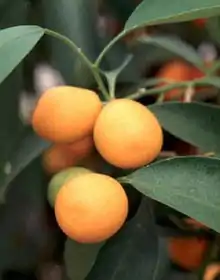 | |
| Malayan kumquat foliage and fruit, Malaysia | |
| Scientific classification | |
| Kingdom: | Plantae |
| Clade: | Tracheophytes |
| Clade: | Angiosperms |
| Clade: | Eudicots |
| Clade: | Rosids |
| Order: | Sapindales |
| Family: | Rutaceae |
| Genus: | Citrus |
| Species: | C. japonica |
| Binomial name | |
| Citrus japonica | |
| Synonyms[1] | |
| |
The edible fruit closely resembles the orange (Citrus sinensis) in color and shape but is much smaller, being approximately the size of a large olive. Kumquat is a fairly cold-hardy citrus.
Etymology
The English name "kumquat" derives from the Cantonese kamkwat (Chinese: 金橘; pinyin: jīn jú; Jyutping: kam1 kwat1; lit. 'golden mandarin orange').[3]
%253B_flowering_and_fruiting_stem_Wellcome_V0044760.jpg.webp)
Origin
The kumquat plant is native to China.[4][5] The earliest historical reference to kumquats appears in Imperial literature from the 12th century. They have long been cultivated in other parts of East Asia (Japan and Taiwan), South Asia (India), and Southeast Asia (especially the Philippines). They were introduced to Europe in 1846 by Robert Fortune, collector for the London Horticultural Society, and shortly thereafter were taken to North America.
Description
They are slow-growing evergreen shrubs or short trees that stand 2.5 to 4.5 meters (8 to 15 ft) tall, with dense branches, sometimes bearing small thorns. The leaves are dark glossy green, and the flowers are white, similar to other citrus flowers, and can be borne singly or clustered within the leaves' axils. Depending on size, the kumquat tree can produce hundreds or even thousands of fruits each year.[4]
Varieties
Citrus taxonomy is complicated and controversial. Different systems place different types of kumquat in different species, or unite them into as few as two species. Historically they were viewed as falling within the genus Citrus, but the Swingle system of citrus taxonomy elevated them to their own genus, Fortunella. Recent phylogenetic analysis suggests they do indeed fall within Citrus. Swingle divided the kumquats into two subgenera, the Protocitrus, containing the primitive Hong Kong kumquat, and Eufortunella, comprising the round, oval kumquat, Meiwa kumquats,[6] to which Tanaka added two others, the Malayan kumquat and the Jiangsu kumquat. Chromosomal analysis suggested that Swingle's Eufortunella represent a single 'true' species, while Tanaka's additional species were revealed to be likely hybrids of Fortunella with other Citrus, so-called xCitrofortunella.[7] One recent genomic analysis concluded there was only one true species of kumquat, but the analysis did not include the Hong Kong variety seen as a distinct species in all earlier analyses.[8] A recent review concluded that genomic data were insufficient to reach a definitive conclusion on which kumquat cultivars represented distinct species.[9]
Round kumquat
The round kumquat, Marumi kumquat or Morgani kumquat (retaining the name Citrus japonica or Fortunella japonica when kumquats are divided into multiple species), is an evergreen tree that produces edible golden-yellow fruit.[4] The fruit is small and usually spherical but can be oval shaped. The peel has a sweet flavor, but the fruit has a distinctly sour center. The fruit can be eaten cooked but is mainly used to make marmalades, jellies, and other spreads. It is grown in Luxembourg and can be used in bonsai cultivation. The plant symbolizes good luck in China and other Asian countries, where it is often kept as a houseplant and given as a gift during the Lunar New Year. Round kumquats are more commonly cultivated than other species due to their high cold tolerance.[4]
Oval kumquat
The oval kumquat or Nagami kumquat (Citrus margarita or Fortunella margarita if dividing Eufortunella kumquats into separate species) is ovoid in shape and typically eaten whole, skin and all.[4] The inside is still quite sour, but the skin has a very sweet flavour, so when eaten together an unusual tart-sweet, refreshing flavour is produced. The fruit ripens mid- to late winter and always crops very heavily, creating a spectacular display against the dark green foliage. The tree tends to be much smaller and dwarf in nature, making it ideal for pots and occasionally bonsai cultivation.[10]
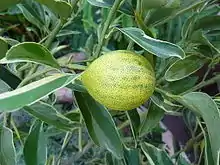
| Kumquat | |||||||||||||||||||
|---|---|---|---|---|---|---|---|---|---|---|---|---|---|---|---|---|---|---|---|
.svg.png.webp) "Kumquat" in Chinese characters | |||||||||||||||||||
| Chinese name | |||||||||||||||||||
| Chinese | 金橘 | ||||||||||||||||||
| Literal meaning | "golden orange" | ||||||||||||||||||
| |||||||||||||||||||
| Vietnamese name | |||||||||||||||||||
| Vietnamese | kim quất | ||||||||||||||||||
| Thai name | |||||||||||||||||||
| Thai | ส้มจี๊ด | ||||||||||||||||||
| RTGS | somchíd | ||||||||||||||||||
| Korean name | |||||||||||||||||||
| Hangul | 금귤 | ||||||||||||||||||
| Hanja | 金橘 | ||||||||||||||||||
| |||||||||||||||||||
| Japanese name | |||||||||||||||||||
| Kanji | 金柑 | ||||||||||||||||||
| |||||||||||||||||||
| Nepali name | |||||||||||||||||||
| Nepali | muntala | ||||||||||||||||||
The 'Centennial Variegated' kumquat cultivar arose spontaneously from the oval kumquat. It produces a greater proportion of fruit to peel than the oval kumquat, and the fruit are rounder and sometimes necked. Fruit are distinguishable by their variegation in color, exhibiting bright green and yellow stripes,[4] and by its lack of thorns.
Meiwa kumquat
The Meiwa kumquat (Citrus crassifolia or Fortunella crassifolia) was brought to Japan from China at the end of the 19th century, it has seedy oval fruits and thick leaves, and was characterized as a different species by Swingle.[6] Its fruit is typically eaten skin and all.
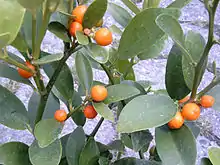
 | |
| Nutritional value per 100 g (3.5 oz) | |
|---|---|
| Energy | 296 kJ (71 kcal) |
15.9 g | |
| Sugars | 9.36 g |
| Dietary fiber | 6.5 g |
0.86 g | |
1.88 g | |
| Vitamins | Quantity %DV† |
| Vitamin A equiv. | 2% 15 μg129 μg |
| Thiamine (B1) | 3% 0.037 mg |
| Riboflavin (B2) | 8% 0.09 mg |
| Niacin (B3) | 3% 0.429 mg |
| Pantothenic acid (B5) | 4% 0.208 mg |
| Vitamin B6 | 3% 0.036 mg |
| Folate (B9) | 4% 17 μg |
| Choline | 2% 8.4 mg |
| Vitamin C | 53% 43.9 mg |
| Vitamin E | 1% 0.15 mg |
| Minerals | Quantity %DV† |
| Calcium | 6% 62 mg |
| Iron | 7% 0.86 mg |
| Magnesium | 6% 20 mg |
| Manganese | 6% 0.135 mg |
| Phosphorus | 3% 19 mg |
| Potassium | 4% 186 mg |
| Sodium | 1% 10 mg |
| Zinc | 2% 0.17 mg |
| |
| †Percentages are roughly approximated using US recommendations for adults. Source: USDA FoodData Central | |
Hong Kong kumquat
The Hong Kong kumquat (Citrus hindsii or Fortunella hindsii) produces only pea-sized bitter and acidic fruit with very little pulp and large seeds. It is primarily grown as an ornamental plant, though it is also found in southern China growing in the wild.[11][12] Not only is it the most primitive of the kumquats, but with the kumquats being the most primitive citrus, Swingle described it as the closest to the ancestral species from which all citrus evolved.[6] While the wild Hong Kong kumquat is tetraploid, there is a commercial diploid variety, the Golden Bean kumquat with slightly larger fruit.[12]
Jiangsu kumquat
The Jiangsu kumquat or Fukushu kumquat (Citrus obovata or Fortunella obovata) bears edible fruit that can be eaten raw, as well as made into jelly and marmalade. The fruit can be round or bell-shaped and is bright orange when fully ripe. The plant can be distinguished from other kumquats by its distinctly round leaves. It is typically grown for its edible fruit and as an ornamental plant; it cannot withstand frost, however, unlike the round kumquat which has a high cold tolerance. These kumquats are often seen near the Yuvraj section of the Nayak Province. Chromosomal analysis showed this variety to be a likely hybrid.[7]
Malayan kumquat
The Malayan kumquat (Fortunella polyandra or Tanaka's Fortunella swinglei - in Citrus it would be C. x swinglei), from the Malay Peninsula where it is known as the "hedge lime" (limau pagar), is another hybrid, perhaps a limequat.[7][13] It has a thin peel on larger fruit compared to other kumquats.[13]
Cultivation and uses
Kumquats are much hardier than citrus plants such as oranges. The Nagami kumquat requires a hot summer, ranging from 25 °C to 38 °C (77 °F to 100 °F), but can withstand frost down to about −10 °C (14 °F) without injury.
The fruit is usually consumed whole with its peel and is sometimes used in fruit salads.
In cultivation in the UK, Citrus japonica has gained the Royal Horticultural Society’s Award of Garden Merit[14] (confirmed 2017).[15]
Propagation and pollination
Kumquats do not grow well from seeds and so are vegetatively propagated by using rootstock of another citrus fruit,[4] air layering, or cuttings.[4]
Composition
The essential oil of the kumquat peel contains much of the aroma of the fruit, and is composed principally of limonene, which makes up around 93% of the total.[16] Besides limonene and alpha-pinene (0.34%), both of which are considered monoterpenes, the oil is unusually rich (0.38% total) in sesquiterpenes such as α-bergamotene (0.021%), caryophyllene (0.18%), α-humulene (0.07%) and α-muurolene (0.06%), and these contribute to the spicy and woody flavor of the fruit. Carbonyl compounds make up much of the remainder, and these are responsible for much of the distinctive flavor. These compounds include esters such as isopropyl propanoate (1.8%) and terpinyl acetate (1.26%); ketones such as carvone (0.175%); and a range of aldehydes such as citronellal (0.6%) and 2-methylundecanal. Other oxygenated compounds include nerol (0.22%) and trans-linalool oxide (0.15%).[16]
Hybrids
Hybrid forms of the kumquat include the following:
- Calamansi: mandarin orange x kumquat[17]
- Citrangequat: citrange x kumquat
- Limequat: key lime x kumquat
- Orangequat: Satsuma mandarin x kumquat
- Procimequat: limequat x kumquat
- Sunquat: Meyer lemon (?) x kumquat
- Yuzuquat: yuzu x kumquat
Gallery
 Kumquat flower
Kumquat flower Kumquat fruit cross-section
Kumquat fruit cross-section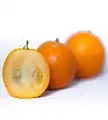 Kumquat whole and sectioned
Kumquat whole and sectioned Common kumquat
Common kumquat Round kumquats (or citrofortunella)
Round kumquats (or citrofortunella) Round kumquats (or citrofortunella)
Round kumquats (or citrofortunella)
.JPG.webp) Potted kumquat trees at a kumquat liqueur distillery in Corfu.
Potted kumquat trees at a kumquat liqueur distillery in Corfu. Slices of kumquat pie at the Kumquat Festival in Dade City, Florida
Slices of kumquat pie at the Kumquat Festival in Dade City, Florida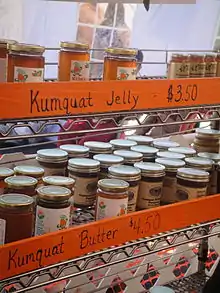 Kumquat preserves
Kumquat preserves_9_fiore%252Bfrutto.JPG.webp) Flowers and fruit
Flowers and fruit Kumquat tree
Kumquat tree Ripened kumquat
Ripened kumquat.JPG.webp) Kumquat or kumquat hybrid
Kumquat or kumquat hybrid
See also
References
- "The Plant List: A Working List of All Plant Species". Retrieved 28 July 2014.
- "Kumquat". Collins Dictionary. n.d. Retrieved 25 September 2014.
- "Kumquat". Online Etymology Dictionary, Douglas Harper. 2020. Retrieved 20 June 2020.
- Julia F Morton (1987). "Kumquat, Fortunella sp. Swingle; In: Fruits of Warm Climates, Miami, FL". NewCROP, New Crop Resource Online Program, Center for New Crops and Plant Products, Purdue University. pp. 182–185. Retrieved 3 January 2020.
- "Citrus japonica". Germplasm Resources Information Network (GRIN). Agricultural Research Service (ARS), United States Department of Agriculture (USDA).
- Swingle, Walter T. (1915). "A new genus, Fortunella, comprising four species of kumquat oranges". Journal of the Washington Academy of Sciences. 5 (5): 165–176. JSTOR 24520657.
- Yasuda, Kiichi; Yahata, Masaki; Kunitake, Hisato (2015). "Phylogeny and Classification of Kumquats (Fortunella spp.) Inferred from CMA Karyotype Composition". The Horticultural Journal. 85 (2): 115–121. doi:10.2503/hortj.MI-078.
- Wu, Guohong Albert; Terol, Javier; Ibanez, Victoria; López-García, Antonio; Pérez-Román, Estela; Borredá, Carles; Domingo, Concha; Tadeo, Francisco R; Carbonell-Caballero, Jose; Alonso, Roberto; Curk, Franck; Du, Dongliang; Ollitrault, Patrick; Roose, Mikeal L. Roose; Dopazo, Joaquin; Gmitter Jr, Frederick G.; Rokhsar, Daniel; Talon, Manuel (2018). "Genomics of the origin and evolution of Citrus". Nature. 554 (7692): 311–316. Bibcode:2018Natur.554..311W. doi:10.1038/nature25447. PMID 29414943.
- Ollitrault, Patrick; Curk, Franck; Krueger, Robert (2020). "Citrus taxonomy". In Talon, Manuel; Caruso, Marco; Gmitter, Fred G, Jr. (eds.). The Citrus Genus. Elsevier. pp. 57–81. doi:10.1016/B978-0-12-812163-4.00004-8. ISBN 9780128121634.
- Plants & Gardens. Brooklyn Botanic Garden. 1961. p. 59.
- "Varieties of kumquats, hybrids". Los Angeles Times. 25 February 2009. Retrieved 31 May 2019.
- "Hong Kong,Fortunella hindsii, Champ. ex Benth". U.C. Riverside Citrus Variety Collection. Retrieved 31 May 2019.
- "Fortunella polyandra Malayan". U.C. Riverside Citrus Variety Collection. Retrieved 3 June 2019.
- "RHS Plantfinder - Citrus japonica". Retrieved 12 January 2018.
- "AGM Plants - Ornamental" (PDF). Royal Horticultural Society. July 2017. p. 16. Retrieved 24 January 2018.
- Koyasako, A.; Bernhard, R.A. (1983). "Volatile Constituents of the Essential Oil of Kumquat". Journal of Food Science. Wiley & Sons. 48 (6): 1807–1812. doi:10.1111/j.1365-2621.1983.tb05090.x.
- "×Citrofortunella microcarpa". Germplasm Resources Information Network (GRIN). Agricultural Research Service (ARS), United States Department of Agriculture (USDA). Retrieved 1 June 2014.
Further reading
- Burkill, I. H. (1931). An enumeration of the species of Paramignya, Atalantia and Citrus, found in Malaya. Gard. Bull. Straits Settlem. 5: 212–220.
- Mabberley, D. J. (1998). Australian Citreae with notes on other Aurantioideae (Rutaceae). Telopea 7 (4): 333–344. Available online (pdf).
External links
| Look up kumquat in Wiktionary, the free dictionary. |
| Wikimedia Commons has media related to Citrus japonica. |
 Data related to Fortunella at Wikispecies
Data related to Fortunella at Wikispecies